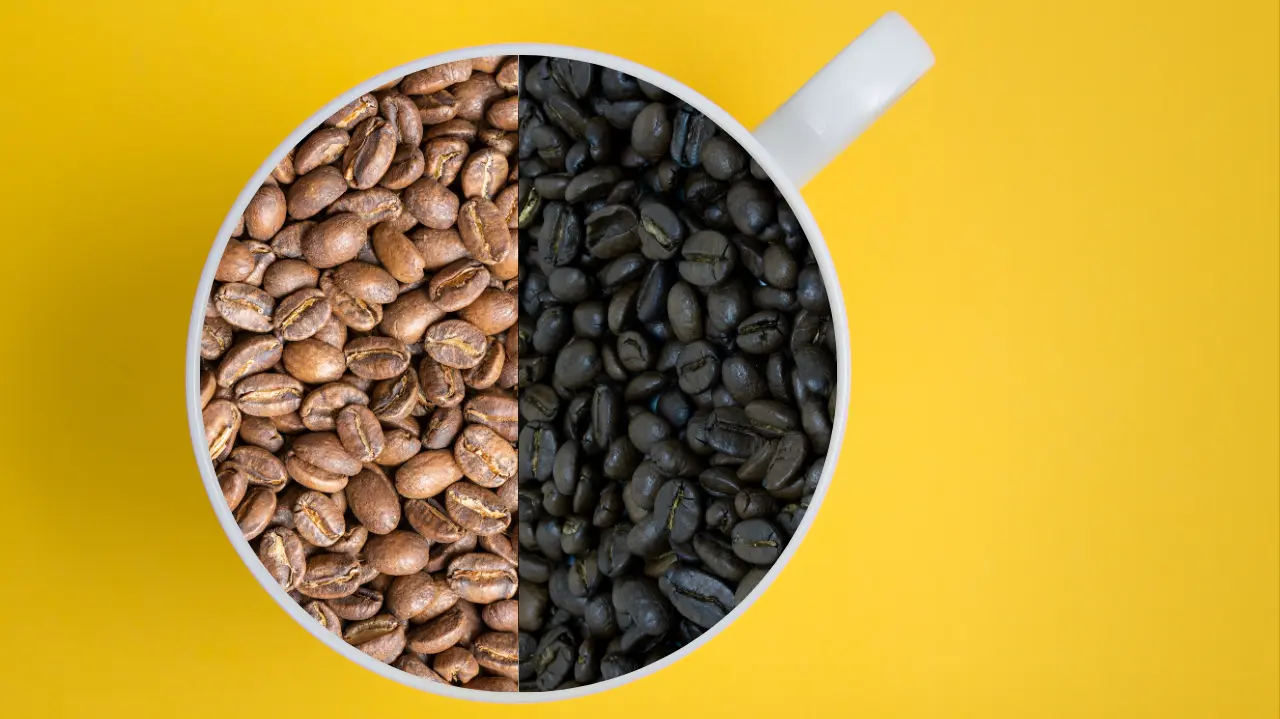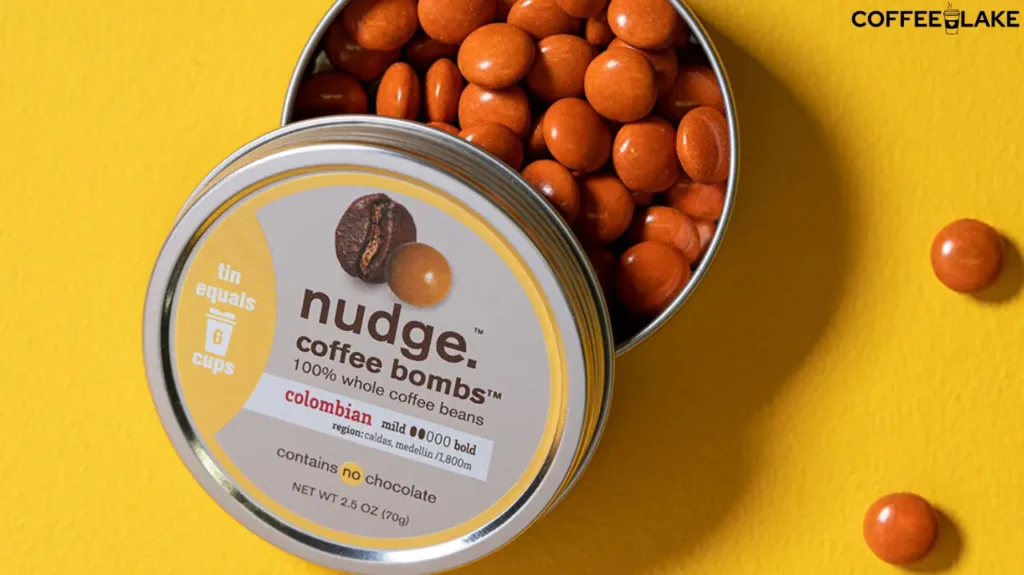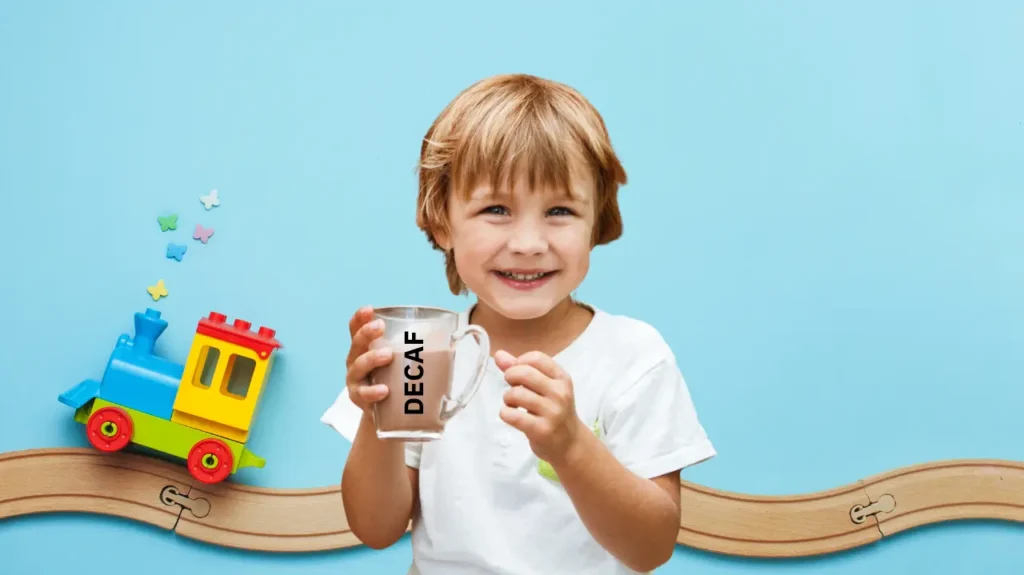You’re staring at a menu, torn between ordering a rich dark roast or that trendy “blonde” coffee. It’s lighter, sweeter, and supposedly packs more caffeine, but is that true?
Coffee lovers are buzzing about blonde roast’s golden colour and smooth, bright flavour.
Yet the considerable debate remains: Does blonde coffee have more caffeine than a dark roast?
Let’s settle this once and for all. We’re not just talking rumours or guesswork.
This guide digs into hard science, expert roasting secrets, and real-world brewing tests to uncover the facts.
Does Blonde Coffee Have More Caffeine Than Dark Roast?
Let’s cut straight to the chase: yes, blonde coffee technically has a hair more caffeine than a dark roast, but we’re talking a razor-thin margin.
Picture this: an 8-ounce cup of light roast drip coffee delivers about 91 mg of caffeine, while dark roast sits at 88 mg. That’s just a 3 mg difference, roughly the caffeine in half a sip of coffee.
Studies back this up, including one from Aerial Resupply Coffee, and Healthline agrees that lighter roasts lose less mass during roasting, so caffeine stays slightly more concentrated.
Why does this happen?
Blame the beans, not the caffeine. Roasting doesn’t destroy caffeine (it’s tough stuff; it can handle up to 470°F!).
But here’s the kicker: dark roasts get cooked longer, causing beans to shrink and lose moisture. Think of it like baking cookies; the longer they stay in the oven, the smaller and crispier they get.
Light roast beans stay denser, so they cram more caffeine into each gram by weight. But the difference nearly vanishes if you measure beans by volume (like using a scoop).
But wait, some experts disagree! Brands like Kicking Horse Coffee claim caffeine levels are nearly identical across roasts.
And they’re not wrong. If you eyeball a scoop of dark roast (fluffier and less dense), you might use slightly more beans, balancing out the caffeine.
This confusion is why coffee nerds fight over scales vs. scoops, and your dark roast tastes stronger (bolder flavours ≠ , more caffeine).
So yes, blonde wins… but barely. The real takeaway? If you’re chasing caffeine, how you brew (and measure!) matters more than roast colour.
Why Does Blonde Coffee Have More Caffeine?
Here’s the science, simplified: coffee beans are like sponges. The longer you roast them, the more they shrink.
Blonde coffee gets a quick roast, around 10 minutes at 350–400°F, so it holds onto more of its original size and weight. Dark roast?
It’s baked longer (up to 15 minutes above 400°F), turning beans into lighter, airier versions of themselves.
Think of it like grilling a steak: leave it on the heat too long, and it’ll dry out and shrink.
Caffeine doesn’t magically vanish during roasting; it’s stubborn. But dark roasts lose up to 18% of their mass from water evaporation and chemical changes, says Healthline.
That means per gram, blonde beans have a tiny caffeine advantage because they’re denser. For example, Health.com found light roasts brew about 60 mg of caffeine per cup vs. dark’s 51 mg.
But here’s the catch: if you measure beans by volume (like a scoop), the fluffier dark roast beans fill the space better, nearly closing the gap.
Wait, why does light roast taste stronger, then?
Blame your taste buds. Light roasts are brighter and more acidic, tricking you into thinking they’re “stronger.” But that tangy kick?
It’s not extra caffeine, just flavour fireworks. Online forums are flooded with drinkers swearing blonde coffee wakes them up faster, but science says it’s mostly psychological.
The real MVP? Density. More bean mass = slightly more caffeine per sip.
So yes, blonde wins, but only if you’re weighing beans, not scooping. Roasting isn’t caffeine’s enemy; shrinkage is.
Does Brewing Method Change How Much Caffeine Blonde Coffee Has?
How do you brew blonde coffee that matters way more than its roast level for caffeine? Think of it like this: using blonde beans is like having premium fuel, but your brewing method is the engine.
Rev it up wrong, and you’ll waste that extra oomph.
Cold Brew = Caffeine King
Steep blonde coffee coarse grounds in cold water for 12+ hours, and you’ll squeeze out roughly 150 mg of caffeine per 4-ounce cup.
Why?
Cold brew uses a 1:4 coffee-to-water ratio, way more beans than drip coffee. Add blonde’s natural density, and you’ve got a smooth, potent jolt. Curious about other cold coffee options? Learn how iced coffee compares.
Espresso: Small but Mighty
Blonde espresso shots are caffeine grenades. A single 1-ounce shot packs 42–122 mg, thanks to high pressure forcing out every drop of caffeine from finely ground beans.
But here’s the kicker: order a Starbucks blonde latte, and you’ll get 3–4 shots, landing you near 300 mg in a grande.
Dark roast?
It’s weaker per shot, so the blonde wins here.
Drip Coffee: The Middle Ground
Your classic drip machine? It’s reliable but not a caffeine powerhouse. A 12-ounce cup of blonde drip coffee lands around 90–110 mg, which is decent, but cold brew nearly doubles that.
Fun fact: studies link drip coffee to heart health benefits, so it’s a trade-off.
French Press: The Underachiever
Do you love the rich, oily flavours of French press?
Sadly, it’s the worst at extracting caffeine. Even with blonde beans, you’ll only get about 70 mg per 8-ounce cup.
The coarse grind and lack of pressure leave caffeine trapped in the grounds.
Want max caffeine from blonde coffee?
Go cold brew or order a multi-shot espresso drink. But remember: bean quantity trumps roast level. Use 20% more blonde beans in a French press, and you’ll easily beat dark roast’s caffeine.
Online coffee forums are split, some swear by blonde cold brew’s “clean buzz,” while others slam espresso shots for instant focus, your move.
Understanding Blonde Coffee
Blonde coffee isn’t “weak”; it’s roasted smarter. Picture this: green coffee beans get a quick 7–9 minute roast at 356–401°F, like a sun-kissed tan instead of a deep burn.
This gentle process locks in the bean’s natural sugars and oils, leaving them golden-brown and bursting with flavours darker roasts destroy.
Specialty roasters like Perkatory call it a “true light roast,” but Starbucks’ version? It’s more of a medium-light—lighter than their dark stuff but still toastier than what coffee snobs sip.
Flavor: Think Citrus, Not Charcoal
Blonde coffee tastes like a fruit market in your mug. Expect bright acidity (that tangy zing!), floral hints, and notes of lemon, peach, or even jasmine.
It’s naturally sweeter and less bitter than dark roasts because the quick roast skips the caramelized “burnt” flavours.
Bonus: its mellow vibe is easier on sensitive stomachs. But here’s the catch: quality matters.
True blonde roasts use top-tier Arabica beans from places like Ethiopia’s highlands or Costa Rica’s volcanic soil, where complex flavours thrive.
Blonde ≠ Basic
Don’t let Starbucks fool you. Their “blonde” is a gateway drug, less intense than their dark roasts but bolder than the delicate light roasts from indie shops.
Third-wave roasters often go lighter, preserving tea-like subtlety that’s worlds away from corporate coffee.
Pro tip: If your blonde roast tastes smoky or heavy, it’s probably not a proper light roast.
In short, blonde coffee is for those who want to taste it, not just endure it.
The Science Behind Caffeine and Roasting
Here’s the million-dollar question: why does blonde coffee get all the hype if roasting doesn’t kill caffeine?
Let’s crack this nut.
Roasting coffee is like popping popcorn. Heat a kernel (or bean), and it puffs up, loses water, and loses weight.
Dark roasts bake longer, so they shrink more; imagine a raisin vs. a grape. Blonde beans, roasted gently, stay plumper.
Since caffeine doesn’t burn off (it’s heat-resistant up to ~470°F!), light roasts keep more caffeine per bean simply because they’re denser.
But wait, there’s data! A Scientific Reports study tested 30 coffee types and found dark roasts brewed less caffeine under identical conditions.
For example, Ethiopian beans brewed at 134–165 mg per cup as a light roast but dipped lower when roasted dark. Why? Dark beans are brittle, so grinding them extracts caffeine less efficiently.
Plus, super-dark roasts (above 420°F) might lose trace caffeine to sublimation, think vanishing ice, but for stimulants.
Here’s the kicker: Aerial Resupply Coffee’s research shows light roasts have a tiny edge by weight, but if you measure beans by the scoop (not grams), dark roast’s fluffiness tricks you into using more beans, balancing the scales.
TL;DR: Yes, blonde’s denser beans = slightly more caffeine by weight. But the difference is a rounding error unless you’re weighing every gram, roast for flavour, not caffeine.
Comparing Caffeine Content
To quantify, let’s compare caffeine levels across roasts. The table below summarizes key findings from various sources:
| Coffee Type | Caffeine Range (mg/8 oz cup) | Espresso Shot (mg) | Notes |
| Blonde/Light Roast | 134–165 | ~85 | Higher caffeine due to shorter roast, retains more natural caffeine. |
| Dark Roast | 134–150 | 64–75 | Lower caffeine per weight due to mass loss, less dense beans. |
| Regular Espresso | N/A | 64–75 | Typically from dark roast, lower than blonde espresso per shot. |
Fun fact: Vietnamese coffee, often made with robusta beans, packs nearly double the caffeine of typical blonde roasts.
Why Choose Blonde Coffee?
People don’t pick blonde coffee just for its tiny caffeine edge. They chose it because it tastes like sunshine in a cup.
Imagine sipping a citrusy, honey-like brew instead of chewing on burnt toast (looking at you, dark roast).
Blonde’s bright acidity and floral notes make it a hit for folks who hate bitterness or get heartburn from darker roasts.
Reddit threads overflow with stories like, “I switched to blonde, and my stomach finally stopped staging mutiny!”
Health Perks? Maybe.
Science hints that light roasts pack more antioxidants like chlorogenic acid, which might fight inflammation.
But let’s be clear: coffee isn’t a vitamin. Still, if you’re gulping three cups a day, every little bit helps. Wondering how caffeine extracts work? Explore the science here.
And since blonde’s lower acidity is gentler on guts, it’s a win for sensitive sippers.
Trend Alert: Blonde is the New Black
Specialty coffee shops are ditching dark, ashy roasts for blonde’s nuanced flavours. Peet’s, Blue
Bottle, and indie roasters now push light roasts as “small-batch” or “single-origin.”
Why?
Drinkers want to taste Ethiopia’s berry notes or Costa Rica’s caramel undertones, not just “coffee flavor.”
TikTok’s full of #blondelatte videos, and pour-over geeks swear it’s the only way to brew.
Bottom Line: Choose blonde to taste your coffee, not survive it. It’s trendy, tummy-friendly, and, technically, has more caffeine. But let’s be honest: you’re here for the vibes.
(P.S. Pro tip: Use blonde in a French press. Its delicate flavours shine without bitterness.)
Brewing Tips for Blonde Coffee
Blonde coffee is like a fragile spice; it’s delicate, so brute-force brewing kills its charm. Nail these tricks to make every sip sing:
Grind Smarter, Not Harder
Aim for a texture like beach sand (medium-fine). Too coarse? You’ll get weak tea. Too fine? Bitter chaos.
Pour-over and drip machines thrive with this grind, pulling out bright flavours without the bite.
Water Temp: Keep It Chill (Kinda)
Boiling water murders subtle notes. Stick to 200°F, just off the boil. Think “hot tub for beans,” not lava.
This gentle heat coaxes out floral and citrus vibes instead of roasting them twice.
Method Matters Most
- Pour-over: Let you control every drip. Perfect for blonde’s nuance.
- French press: Go coarse and steep for 4 minutes. Boom, smooth, full-bodied bliss.
- Espresso: Trickier. Light roasts need lower pressure to avoid sourness. Dial in that grind!
Wildcard Move: Blonde Cold Brew
Reddit’s secret? Steep blonde beans cold for 18 hours. It mutes acidity, amps up nutty sweetness, and delivers a caffeine punch that’ll power your all-nighter.
Debunking Myths
Dark roast’s bold flavour doesn’t mean extra caffeine. In reality, the opposite is true.
Those smoky, intense beans lose up to 18% of their mass during roasting, making them lighter and less caffeine-dense by weight.
Blonde beans, roasted gently, stay heavier, so gram for gram, they edge out the dark roast. Aerial Resupply Coffee’s studies confirm this, yet even baristas often get it wrong.
Myth #2: “All Coffee Has the Same Caffeine”
False.
A Robusta bean packs nearly double the caffeine of Arabica (the star of most blonde roasts). The brew method also flips the script: a cold blonde can out-caffeinate a dark roast espresso.
As Sagebrush Coffee notes, it’s like comparing apples to rocket fuel.
Why Misinformation Brews Chaos
Have you ever argued with a barista who swore blonde roast is weaker? You’re not alone. Reddit threads rage over this.
One user shared: “I had to pull up a study on my phone mid-latte order!” Spread the word; knowledge is power (and better coffee).
TL;DR:
- Dark roast’s “strength” is a flavour trick, not a caffeine boost.
- Blonde’s caffeine edge is small but real if you measure it by weight.
- Bean type (Robusta vs. Arabica) and brewing style matter MORE.
Conclusion
So, does blonde coffee have more caffeine? Yes, barely. Studies clock light roasts at 91 mg per cup vs. dark’s 88 mg. That’s like one extra chocolate chip in your cookie.
Why?
Light roasts are denser and roasted less, so beans retain more mass (and caffeine).
But here’s the kicker: your brewing method flips the script. Cold brew blonde can hit 150 mg, while a dark roast espresso might only hit 75 mg.
Caffeine’s a sneaky beast; it cares more about how you brew than roast colour.
Choose blonde if you crave bright, fruity flavours and a gentler sip (goodbye, bitterness!). Dark roast fans, stick with your smoky vibe.
Both are right; just follow your taste buds. And hey, blonde might sneak in extra antioxidants.




